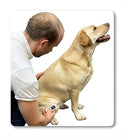Concurrent Validity of Equine Joint Range of Motion Measurement: A Novel Digital Goniometer vs Universal Goniometer
Authors: Anna Bergh (2020)
Link to study: here.
Abstract
Goniometry is the measurement of joint angles with a conventional universal goniometer (UG) or a digital goniometer (DG). The UG is validated for use in dogs and cats. However, it demands both of the user’s hands when measuring. To avoid this, a novel type of DG has been developed, simplifying measurement by offering single-hand usage. The objective of this study is to examine the concurrent validity of the DG.
Methods
The study consists of measurement with the DG and UG for flexion of the carpus and fetlock on ten horses, and with the DG in flexion and neutral positioning of the fetlock on a sedated horse and corresponding radiographs, intra- and inter-tester reliability and a survey on user-friendliness. The data were analyzed with ANOVA and intraclass correlation coefficient (ICC), with a significance of p < 0.05.

Results
The study showed significant differences in range of motion for the carpus and fetlock joint, a 2–3° difference comparing measurements on a sedated horse with corresponding radiographs, a “fair” to “excellent” inter-tester reliability and a “fair” to “almost perfect” intra-tester reliability, and the DG was easier to use than the UG.
Conclusion
In conclusion, the novel DG may serve as a simple tool for measuring joint motion in equine rehabilitation patients.










